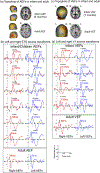Magnetoencephalography and the infant brain
- PMID: 30685329
- PMCID: PMC6662211
- DOI: 10.1016/j.neuroimage.2019.01.059
Magnetoencephalography and the infant brain
Abstract
Magnetoencephalography (MEG) is a non-invasive neuroimaging technique that provides whole-head measures of neural activity with millisecond temporal resolution. Over the last three decades, MEG has been used for assessing brain activity, most commonly in adults. MEG has been used less often to examine neural function during early development, in large part due to the fact that infant whole-head MEG systems have only recently been developed. In this review, an overview of infant MEG studies is provided, focusing on the period from birth to three years. The advantages of MEG for measuring neural activity in infants are highlighted (See Box 1), including the ability to assess activity in brain (source) space rather than sensor space, thus allowing direct assessment of neural generator activity. Recent advances in MEG hardware and source analysis are also discussed. As the review indicates, efforts in this area demonstrate that MEG is a promising technology for studying the infant brain. As a noninvasive technology, with emerging hardware providing the necessary sensitivity, an expected deliverable is the capability for longitudinal infant MEG studies evaluating the developmental trajectory (maturation) of neural activity. It is expected that departures from neuro-typical trajectories will offer early detection and prognosis insights in infants and toddlers at-risk for neurodevelopmental disorders, thus paving the way for early targeted interventions.
Keywords: Auditory; Development; Infant; MEG; Somatosensory; Visual.
Copyright © 2019. Published by Elsevier Inc.
Figures




References
-
- Anderson AL, Thomason ME, 2013. Functional plasticity before the cradle: a review of neural functional imaging in the human fetus. Neurosci. Biobehav. Rev 37, 2220–2232. - PubMed
-
- Association AP, 2000. Diagnostic and Statistical Manual of Mental Disorders, 4 ed. American Psychiatric Association, Washington, DC.
-
- Barnet AB, 1975. Auditory evoked potentials during sleep in normal children from ten days to three years of age. Electroencephalogr. Clin. Neurophysiol 39, 29–41. - PubMed
Publication types
MeSH terms
Grants and funding
LinkOut - more resources
Full Text Sources
Research Materials

